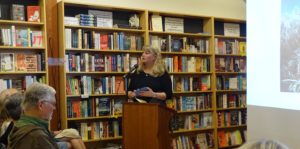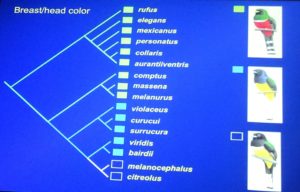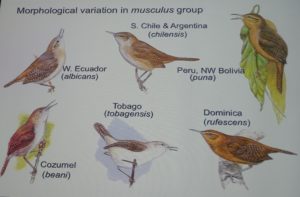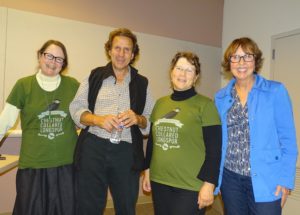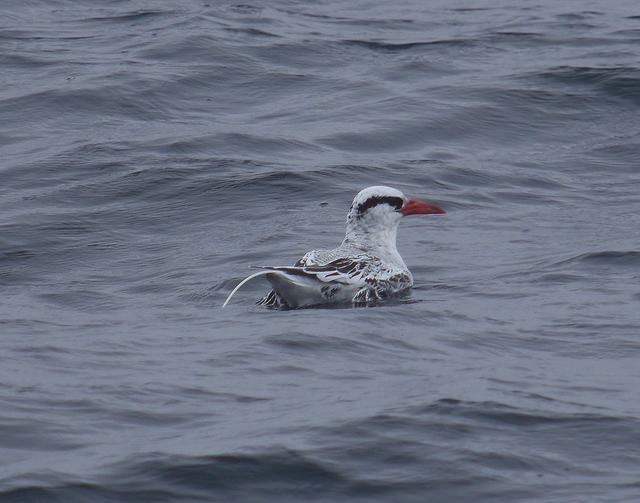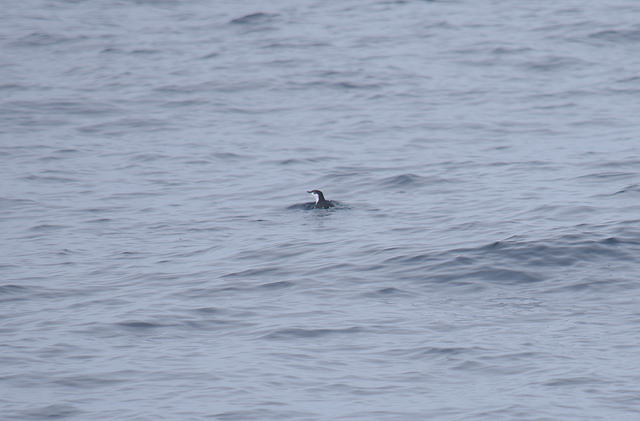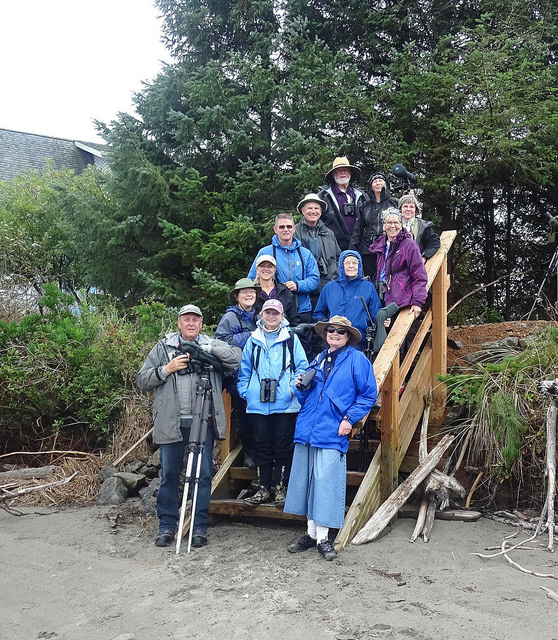
Saturday on the new steps to Bill’s Spit
Ken Brown organized and led a trip to the coast last weekend, and the group of 12 ABC’ers lucked out re weather with showers Saturday only until about 9 AM, a mildly blustery rest of the day, and a gloriously sunny Sunday. I took few photos, none very good, so other birders are encouraged to post flickr or other links in the comments to theirs.
Saturday we headed straight to the Hoquiam Sewer ponds with a potty stop as usual in Elma. There we really saw remarkably few birds, battled some wind and rain, and saw only a smattering of ducks, a fly over by 3 American Pipits, and 19 total species. We then headed to Ocean Shores, where on arrival the sky’s cleared nicely. Little activity was noted at the beach by the Oyhut picnic area, so we went on the Brown’s Point Jetty. By far the most exciting thing there was a large feeding frenzy of birds on an apparent bait ball of fish just off the jetty. We remarkably found zero rocky habitat shorebirds, but enjoyed an estimated 2500 Sooty Shearwaters, 800 Brown Pelicans, and lots of gulls including 300 Heermann’s Gulls. STwo species of alcids were seen including 30 Common Murres and Rhinoceros Aucklet.
Next stop was Bill’s spit, where we went next thinking mid tide would be best. There we did find our only Herring Gulls of the trip, but not the hoped for shorebird flocks. We had lunch and Diane took our group photo (above) there.
From there we birded both ends of the Oyhut Game Range. First the south end entry by the sewer ponds where we found 32 Black Turnstones at the base of the jetty, and studied a good flock of about 350 Western Sandpipers mixed with a few dunlin, least sandpipers, Semi-palmated Plovers, and a lone Black-bellied Plover.
We walked back out and looked in vain for any longspurs. From the Tonquin Ave. end we again located a good flock of mixed peeps, primarily WESA, but found a single Baird’s Sandpiper near the edge of the flock for excellent views.
On the way back to Aberdeen we drove and stopped on Burrow’s Road and again revisited the Hoquiam Sewer ponds hoping for better luck, but really found little of added interest. Dinner as usual at the Mazatlan was good, and we stayed at the old Guesthouse, now a Best Western.
Sunday we had breakfast a bit before the official opening time of 7 AM and got off about 7:10. First stop was at Tokeland, first a drive by At Graveyard Spit where fog prevented any viewing. Next fog again at Tokeland, where we really saw just a few Willets and a Belted Kingfisher.
Next we headed for Midway Beach were a Sharp-tailed Sandpiper was seen the day prior. This turned out the best shore-birding of the trip, with about 17 Pectoral Sandpipers along with an 18th that in flight was intriguing as a possible Sharp-tailed, but remains just intriguing. We also found a Ruff, lots of American Pipits, and a nice fly by of a Golden Plover we called American based on wing length, coloration, and call note.
At Bottle Beach we hit the tide perfectly, but except for a nice group of 5 Baird’s Sandpipers found only a good flock of Black-bellied Plover, a mix of the usual peeps, and relatively few birds that failed to congregate very well as the tide came in.
On the way home we chased Sabine’s Gull in Pierce County at Sunnyside Beach, Steilacom seen earlier that day by Bruce Labar, but without luck.
A nice trip, with 90 species, 17 shorebird species, and a few really nice birds seen. As usual great fellowship and a good time had by all. Thanks to Ken for leading.
Here is an e-Bird trip summary:
Species Name Sep 17 Sep 18 Sep 19 Sep 20 Sep 21 Sep 22 Sep 23
Cackling Goose — 45
(1) — — — — —
Canada Goose 30
(6) — — — — — —
Gadwall 50
(2) — — — — — —
American Wigeon 50
(3) 2
(1) — — — — —
Mallard 80
(6) 1
(1) — — — — —
Mallard (Domestic type) 1
(1) — — — — — —
Northern Shoveler 60
(4) 8
(1) — — — — —
Northern Pintail 100
(5) 40
(2) — — — — —
Green-winged Teal 30
(4) 30
(2) 4
(1) — — — —
Greater Scaup — 3
(1) — — — — —
Surf Scoter 300
(3) 150
(4) 3
(1) — — — —
White-winged Scoter 13
(2) 30
(1) — — — — —
Barrow’s Goldeneye — 1
(1) — — — — —
Common Merganser 1
(1) — — — — — —
Red-throated Loon 2
(2) — — — — — —
Pacific Loon 20
(1) — — — — — —
Common Loon 4
(3) 1
(2) 4
(1) — — — —
Pied-billed Grebe 1
(2) — — — — — —
Horned Grebe 2
(1) 3
(1) — — — — —
Red-necked Grebe — 8
(1) 10
(1) — — — —
Western Grebe 20
(1) 8
(2) — — — — —
Sooty Shearwater 2,500
(1) — — — — — —
shearwater sp. 1
(1) — — — — — —
Brandt’s Cormorant 12
(1) 4
(1) — — — — —
Pelagic Cormorant 8
(2) 6
(4) — — — — —
Double-crested Cormorant 15
(6) 4
(4) 2
(1) — — — —
cormorant sp. — 200
(2) — — — — —
Brown Pelican 800
(3) 60
(5) — — — — —
Great Blue Heron 3
(6) 1
(2) — — — — —
Great Egret — 2
(1) — — — — —
Turkey Vulture 2
(1) — — — — — —
Northern Harrier 1
(2) — — — — — —
Sharp-shinned Hawk — 1
(1) — — — — —
Black-bellied Plover 8
(3) 80
(1) — — — — —
American Golden-Plover — 1
(1) — — — — —
Semipalmated Plover 12
(2) — — — — — —
Killdeer 2
(2) — — — — — —
Bar-tailed Godwit — 1
(1) — — — — —
Marbled Godwit — 1,000
(2) — — — — —
Black Turnstone 32
(1) 11
(1) — — — — —
Ruff — 1
(1) — — — — —
Sanderling 5
(2) 1
(1) — — — — —
Dunlin 7
(1) — — — — — —
Baird’s Sandpiper 1
(1) 5
(1) — — — — —
Least Sandpiper 40
(4) 20
(1) — — — — —
Pectoral Sandpiper — 18
(1) — — — — —
Western Sandpiper 350
(3) 200
(1) — — — — —
peep sp. 11
(2) 2
(1) — — — — —
Long-billed Dowitcher — 2
(1) — — — — —
Greater Yellowlegs 1
(1) 3
(1) — — — — —
Willet — 8
(1) — — — — —
Common Murre 30
(1) 7
(1) — — — — —
Pigeon Guillemot — 1
(1) — — — — —
Rhinoceros Auklet 6
(1) — 1
(1) — — — —
Bonaparte’s Gull — 2
(1) — — — — —
Heermann’s Gull 300
(2) 300
(4) — — — — —
Mew Gull 4
(2) 1
(2) — — — — —
Ring-billed Gull 50
(4) 80
(1) — — — — —
Western Gull 6
(5) 4
(3) — — — — —
California Gull 200
(6) 500
(3) — — — — —
Herring Gull 2
(1) — — — — — —
Glaucous-winged Gull 12
(5) — 2
(1) — — — —
Western x Glaucous-winged Gull (hybrid) 20
(1) — — — — — —
Western/Glaucous-winged Gull 280
(8) 100
(6) 14
(1) — — — —
gull sp. — 400
(1) 10
(1) — — — —
Caspian Tern 8
(5) 6
(3) — — — — —
Rock Pigeon — 12
(1) 2
(1) — — — —
Eurasian Collared-Dove — 1
(1) — — — — —
Mourning Dove — 1
(1) — — — — —
Belted Kingfisher — 1
(1) — — — — —
Northern Flicker 1
(1) 3
(3) 1
(1) — — — —
Peregrine Falcon 1
(1) 2
(1) — — — — —
Steller’s Jay 1
(1) — — — — — —
American Crow 4
(7) 4
(2) 6
(1) — — — —
Common Raven — 2
(2) — — — — —
Barn Swallow 12
(2) 11
(2) — — — — —
European Starling 40
(1) 400
(2) 4
(1) — — — —
American Pipit 8
(3) 50
(2) — — — — —
Cedar Waxwing 1
(1) 1
(1) — — — — —
Orange-crowned Warbler — 1
(1) — — — — —
Common Yellowthroat 1
(1) 4
(1) — — — — —
Yellow-rumped Warbler — 2
(2) — — — — —
White-crowned Sparrow — 1
(1) — — — — —
Golden-crowned Sparrow 1
(1) — — — — — —
Savannah Sparrow 30
(8) 30
(2) — — — — —
Song Sparrow 2
(2) 2
(2) — — — — —
Red-winged Blackbird — 2
(2) — — — — —
Brewer’s Blackbird — 20
(1) — — — — —
House Finch 5
(1) — — — — — —
House Sparrow — 2
(1) 8
(1) — — — —

